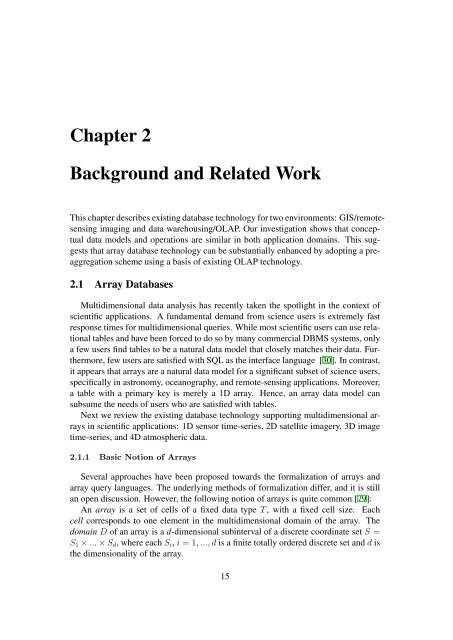Applying OLAP Pre-Aggregation Techniques to ... - Jacobs University
Applying OLAP Pre-Aggregation Techniques to ... - Jacobs University
Applying OLAP Pre-Aggregation Techniques to ... - Jacobs University
You also want an ePaper? Increase the reach of your titles
YUMPU automatically turns print PDFs into web optimized ePapers that Google loves.
Chapter 2<br />
Background and Related Work<br />
This chapter describes existing database technology for two environments: GIS/remotesensing<br />
imaging and data warehousing/<strong>OLAP</strong>. Our investigation shows that conceptual<br />
data models and operations are similar in both application domains. This suggests<br />
that array database technology can be substantially enhanced by adopting a preaggregation<br />
scheme using a basis of existing <strong>OLAP</strong> technology.<br />
2.1 Array Databases<br />
Multidimensional data analysis has recently taken the spotlight in the context of<br />
scientific applications. A fundamental demand from science users is extremely fast<br />
response times for multidimensional queries. While most scientific users can use relational<br />
tables and have been forced <strong>to</strong> do so by many commercial DBMS systems, only<br />
a few users find tables <strong>to</strong> be a natural data model that closely matches their data. Furthermore,<br />
few users are satisfied with SQL as the interface language [30]. In contrast,<br />
it appears that arrays are a natural data model for a significant subset of science users,<br />
specifically in astronomy, oceanography, and remote-sensing applications. Moreover,<br />
a table with a primary key is merely a 1D array. Hence, an array data model can<br />
subsume the needs of users who are satisfied with tables.<br />
Next we review the existing database technology supporting multidimensional arrays<br />
in scientific applications: 1D sensor time-series, 2D satellite imagery, 3D image<br />
time-series, and 4D atmospheric data.<br />
2.1.1 Basic Notion of Arrays<br />
Several approaches have been proposed <strong>to</strong>wards the formalization of arrays and<br />
array query languages. The underlying methods of formalization differ, and it is still<br />
an open discussion. However, the following notion of arrays is quite common [79]:<br />
An array is a set of cells of a fixed data type T , with a fixed cell size. Each<br />
cell corresponds <strong>to</strong> one element in the multidimensional domain of the array. The<br />
domain D of an array is a d-dimensional subinterval of a discrete coordinate set S =<br />
S 1 × ... × S d , where each S i , i = 1, ..., d is a finite <strong>to</strong>tally ordered discrete set and d is<br />
the dimensionality of the array.<br />
15
















